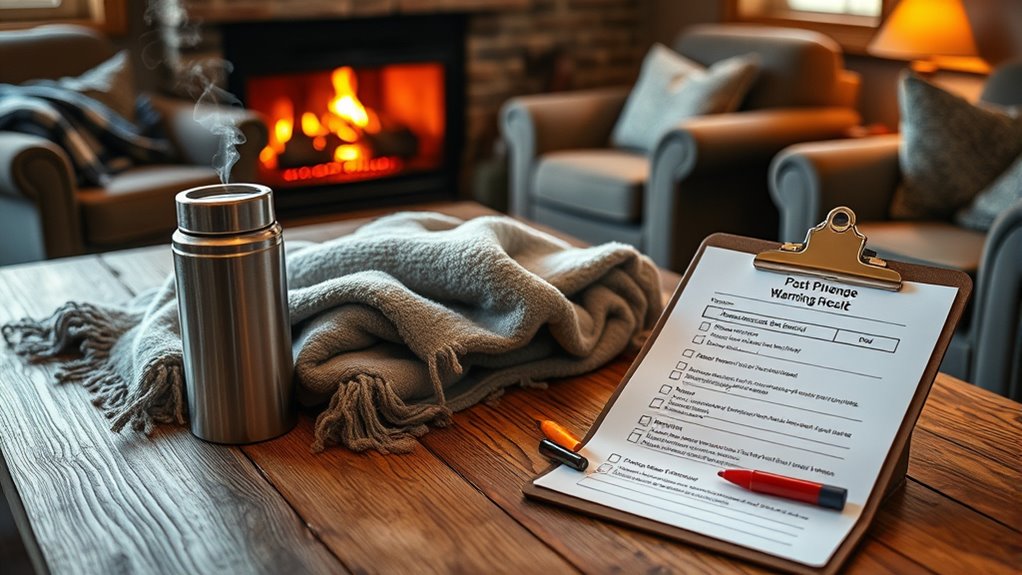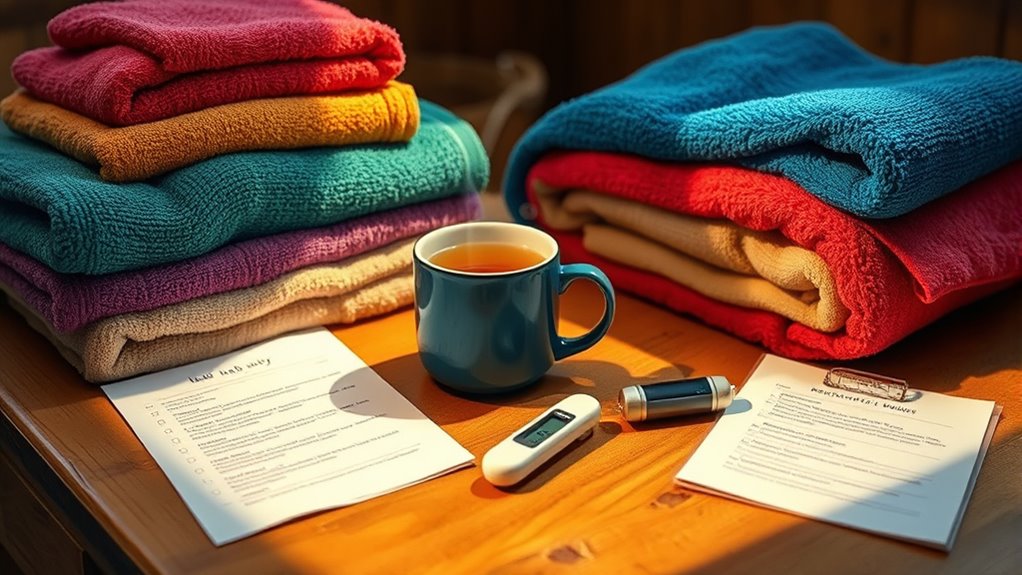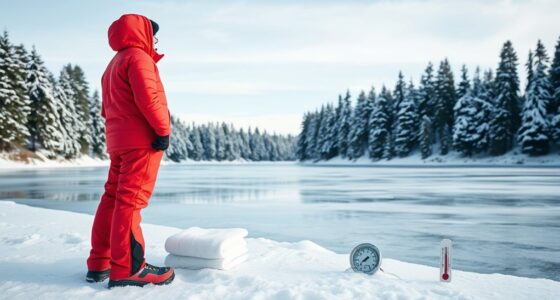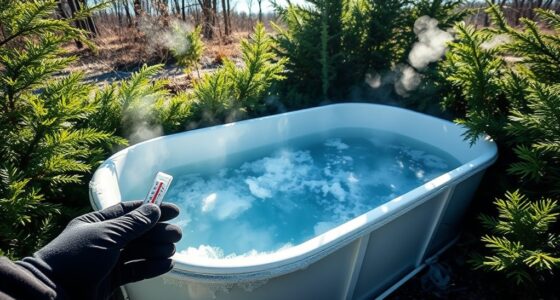Before you begin post-plunge warming, make sure you dry off quickly with a towel and move to a warm environment like a heated room or sauna. Wear insulating layers or cozy clothing to trap your body heat, and add a hat or gloves if outdoors. Engage in gentle movement to promote circulation, and sip warm fluids or eat nourishing snacks to support internal warming. Being aware of your body’s signals and safety techniques will help you recover effectively—continue to explore these strategies for maximum recovery.
Key Takeaways
- Dry off promptly and move to a warm, stable environment to prevent rapid temperature shifts.
- Wear insulated clothing, including hats and gloves, to retain body heat during recovery.
- Engage in gentle movement or stretching to boost circulation and internal warming.
- Drink warm fluids and eat balanced snacks to support internal temperature regulation.
- Monitor bodily signs and use blankets or heating aids if feeling excessively cold or unwell.
Warming Strategies for Post-Cold Plunge Recovery

After a cold plunge, warming up properly is essential to prevent hypothermia and promote recovery. Cold exposure triggers your body to react by constricting blood vessels and reducing blood flow to your extremities, which can leave you feeling chilled and vulnerable if you don’t follow the right recovery techniques. That’s why having a solid warming strategy is critical to safely transition from cold exposure back to a normal body temperature. It’s not just about comfort; it’s about guaranteeing your body recovers effectively and minimizes potential risks associated with rapid temperature changes.
Begin by drying off quickly with a towel. Moisture keeps cold exposure lingering, so removing excess water helps your body start to warm up faster. Once dry, you should move to a warm environment—ideally a heated room or sauna—where you can begin to raise your core temperature gradually. Avoid jumping straight into hot showers or baths immediately after cold exposure, as sudden temperature shifts can cause blood vessels to dilate rapidly, leading to dizziness or fainting. Instead, opt for a comfortable, steady warmth that encourages blood flow without shocking your system.
Dry off quickly and warm up gradually in a heated environment to prevent sudden temperature shocks.
Layering clothing is another recovery technique that works wonders. Wear warm, insulated clothes or a cozy robe to trap body heat and support natural warming. If you’re outdoors, a hat and gloves can help secure warmth, since much body heat escapes from extremities. Incorporating gentle movement, such as walking or light stretching, can accelerate circulation and help your body reestablish normal blood flow. This active recovery technique encourages heat production through muscle activity, which complements passive warming measures.
Hydrating is often overlooked but plays a crucial role in post-plunge recovery. Cold exposure can dehydrate you slightly, so drinking warm fluids like herbal tea or warm water with lemon helps restore hydration and encourages internal warming. Proper nutrition also supports your body’s recovery process; opt for balanced snacks rich in healthy fats, proteins, and carbohydrates to replenish energy and aid in temperature regulation.
Additionally, understanding the importance of core temperature regulation is vital, as it guides safe recovery practices and helps prevent complications. Finally, listen to your body. If you start feeling excessively cold, dizzy, or uncomfortable, take additional steps such as wrapping yourself in blankets or using a heating pad. Remember, the goal of post-plunge warming strategies is to restore your core temperature safely and efficiently—no shortcuts. By following these recovery techniques, you guarantee a smooth transition back to normal warmth, safeguard the risk of hypothermia, and enhance the overall benefits of your cold exposure experience. Proper warming isn’t just about comfort; it’s an indispensable part of a safe, effective cold plunge routine.
Frequently Asked Questions
How Long Should I Wait Before Warming up After a Cold Plunge?
You should wait about 10 to 15 minutes before warming up after a cold plunge. This allows your body to recover from the cold shock and helps with thermal regulation. Rushing into warming up too quickly can cause dizziness or discomfort. Use gentle methods like dry clothing or warm blankets to gradually raise your body temperature, ensuring your body adjusts safely and effectively after experiencing cold exposure.
Are There Any Risks Associated With Rapid Warming After Cold Exposure?
Rapid warming after cold exposure can release the dangers of sudden temperature shifts, risking hypothermia or even cardiac stress. You might think a quick warm-up speeds recovery, but it could overload your system, causing dizziness or fainting. Always warm up gradually to respect your body’s limits—this way, you avoid the exaggerated risks of abrupt temperature changes and keep your recovery safe and steady.
What Are the Best Clothing Options for Post-Plunge Warming?
You should choose layering strategies with moisture-wicking fabrics for ideal post-plunge warming. Start with a moisture-wicking base layer to keep sweat away from your skin, then add insulating layers like fleece or wool to trap heat. Top it with a waterproof or windproof outer layer if needed. This combination helps you warm up quickly, stay dry, and maintain comfort after cold exposure, ensuring a safe and effective recovery.
Can Eating Immediately After a Cold Plunge Aid in Warming?
Eating immediately after a cold plunge can aid in warming by supporting your body’s nutritional timing and energy recovery. Consuming warm, nutrient-rich foods helps boost circulation and core temperature. Pair this with proper hydration strategies to replenish fluids lost during the cold exposure. Focus on balanced snacks or meals that provide carbs and protein, which will help your body restore warmth and promote faster recovery after the plunge.
How Can I Tell if I’M Warming up Too Quickly or Too Slowly?
Think of yourself as Goldilocks, seeking the “just right” warmth. You can tell if you’re warming up too quickly or slowly by watching your temperature cues and comfort indicators. If you start sweating or feel overheated, you’re warming too fast. Conversely, if you remain chilled and uncomfortable, you’re warming up too slowly. Listen to your body’s signals, and adjust your pace for a safe, balanced recovery.
Conclusion
As you emerge from the cold, remember that your recovery is like tending to a delicate garden. Each warming strategy is a gentle sunbeam nurturing your resilience, helping you bloom anew. Embrace these steps as a symbolic dawn, transforming cold shadows into warmth and vigor. With patience and care, you’ll find your inner spring awakening, ready to flourish in the warmth of renewed energy and strength.









